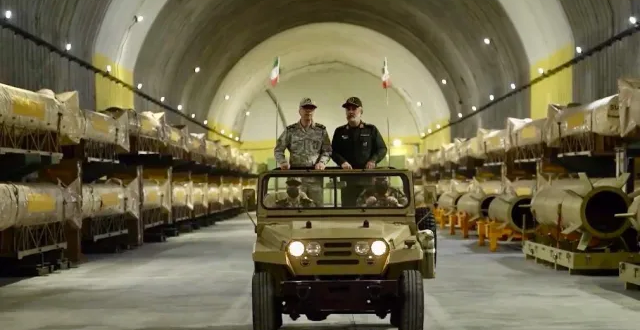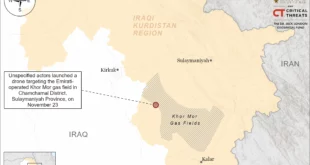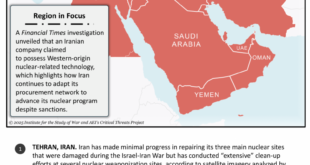Iran is seeking to maintain diplomacy alongside a military threat, said an analyst in Tehran
Iran revealed a vast underground “missile city” packed with long-range weaponry this week, as the regime aims to restore deterrence against Israel and the US.
The chief of staff of Iran’s armed forces, Major-General Mohammad Bagheri, attended a tour of the site and claimed his forces could unleash a “capability that is 10 times greater than the one deployed during Operation True Promise II” – when Tehran fired 200 ballistic missiles at Israel last October during the first open exchange of fire between the long-time adversaries.
Iranian defence experts identified missiles with ranges of up to 1,500 miles in a video of the vaults published by the military, capable of reaching every location in Israel.
The regime is seeking to restore deterrence after Israel’s success in weakening allied militias such as Hezbollah and Hamas, and strikes on Iran’s own military sites during last year’s exchanges, analysts say, amid threats of further attacks from Israel and the US.
Israel’s prime minister, Benjamin Netanyahu, recently called for US support to “finish the job on Iran”, while top Trump officials have held out the threat of military action if diplomacy on Iran’s nuclear programme fails.
“[Donald Trump] would much prefer to work this out diplomatically without a war,” said US Secretary of State Marco Rubio last week. “But if you force him to choose between a nuclear Iran or taking action, the President has been clear he will take action.”
Iran maintains its nuclear programme is peaceful, and US intelligence has not detected efforts to weaponise it. But the Islamic republic has also steadily enriched uranium to the point of being on the threshold of a nuclear bomb, according to independent experts, with a breakout time of as little as weeks.
Trump himself has said “Iran will be held responsible” for Houthi attacks as the US escalates air strikes against the Iran-backed Yemeni group, and builds up forces in the region.
Iran has said it will not negotiate directly with the US under the strict sanctions imposed under Trump’s “maximum pressure” policy, but has offered indirect talks. However, top US officials have said they will seek “full dismantlement” of Iran’s nuclear programme, which Tehran has rejected.
The regime is seeking to maintain parallel tracks of diplomacy combined with deterrence, said Saeed Azimi, a journalist and analyst based in Tehran.
“Iran’s foreign minister Abbas Araghchi is actively engaged with the inner power circle in Tehran to get the green light for talking with the US,” he told The i Paper. “Concurrently, the Iranian military … [is] actively boosting defence capabilities and unveiling new achievements as part of the ‘offer incentives, threaten’ policy.”
Dr Raz Zimmt, a security analyst and Iran researcher at the Institute for National Security Studies in Tel Aviv, said recent displays by the Iranian military suggest increasing concern they could come under attack.
“Several military manoeuvres, and then this video, in my view, testified to growing Iranian concern over the possibility of an Israeli military attack in the next few months,” he said.
Those fears may be well-founded, Dr Zimmt suggested, with Israeli leaders discussing a “window of opportunity” to strike Iran’s nuclear facilities while the regime’s allies and domestic capabilities are weakened, with the assumption that they will eventually recover.
Iran is reportedly expediting deliveries of material for producing ballistic missiles from China, and new air defence systems from Russia, which could repair the damage caused by Israeli strikes.
Even in a weakened state, the threat of Iranian retaliation would not be taken lightly by Israel, said Dr Zimmt.
“There is no doubt that Iran’s ballistic missiles can still inflict major damage on Israel, even if most of those missiles will be intercepted by Israel or the US,” he said, noting that even isolated strikes by the Houthis have proved challenging for Israel.
Tehran has other options to deter or punish an attack, said Ken Katzman, a former CIA official specialising on Iran now at the Soufan Centre think-tank.
Iran has previously attacked the oil infrastructure of Western allies in the Gulf, he noted, affecting global oil prices.
The regime has also been prepared to launch attacks on US targets, such as a missile strike on the al-Asad airbase in Iraq in 2020 after Trump ordered the assassination of Qassem Solemani, a key military figure, during his first term.
“They have been willing to take punishments and retaliate in the past,” said Katzman. “They are not without leverage.”
Dr Farzan Sabet, managing researcher and specialist on Iran’s military at the Geneva Graduate Institute, said Iran had numerous potential lines of attack.
Tehran’s “vast arsenal” of missiles and drones could be used to “target the US military footprint in the Middle East; saturate Israeli military and strategic sites; and hit energy product and export infrastructure in and surrounding the Persian Gulf and beyond,” he said.
“Iran can also use various capabilities to obstruct maritime energy traffic through the Strait of Hormuz, which would increase global oil prices.”
Tehran also has the card of responding to any strike by making a “breakout” to a nuclear bomb in the event of an attack, notes Dr Zimmt.
In the case of a combined Israeli-US attack on Iran’s nuclear sites, the analyst said he would expect the regime “to reconstitute and rehabilitate as quickly as possible their nuclear programme with some of the material that remained … and try to build a nuclear warhead.”
 Eurasia Press & News
Eurasia Press & News



